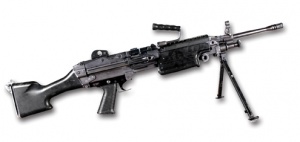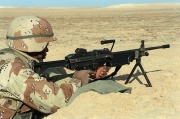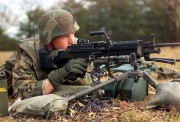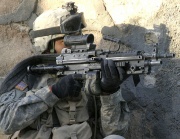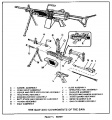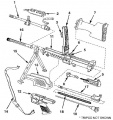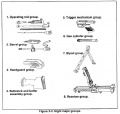M249 Squad Automatic Weapon
| |||||||||||||||||||||||||||||||||||||||||||||||||||
The M249 squad automatic weapon (SAW), formally Squad Automatic Weapon, 5.56mm, M249 is an American version of the FN Minimi manufactured in the United States and used by all branches of the U.S. Armed Forces. The gun was introduced in 1984 and judged the most effective weapon to address the lack of automatic firepower in small units; the only one of a number of candidate designs to successfully pass tests. Tactically, it is employed at squad level and is operated by a designated automatic rifleman. The gun provides the heavy volume of fire of a machine gun with accuracy approaching that of a rifle.
The M249 is gas-operated and air-cooled. It has a quick-change barrel so that an overheated or jammed barrel may be rapidly replaced by the gunner. A folding bipod is attached near the front of the gun, though a heavy fixed tripod is also issued. Due to the weight and age of the weapon, the U.S. Marine Corps is currently considering designs for an infantry automatic rifle which is planned to complement and partially replace the M249 in their service.
Contents |
History
In 1965, the U.S. Army's primary machine guns were the M2 Browning and M60. The M2 was a large calibre heavy machine gun usually mounted on vehicles or in prepared emplacements.[2] The M60 was a more mobile medium machine gun intended to be carried with the troops to provide heavy automatic fire.[3] Both were very heavy weapons and usually required a crew of at least two men to operate efficiently, meaning they were best employed by platoon or larger sized units.[4] The Browning automatic rifle, which had been the army's main individual machine gun since its introduction in World War I, was phased out in the 1950s, as the M14 rifle was scheduled to replace it.[5] Since then, "designated riflemen" in every squad had been ordered to use their weapons on the fully automatic setting. Because army doctrine usually required troops to use a rifle's semi automatic mode on most occasions to increase accuracy and conserve ammunition, the M14 and M16 rifles used by the U.S. Army had not been designed with sustained automatic fire in mind, and overheated or jammed regularly. The 30 round magazine also limited their sustained automatic effectiveness over belt-fed weapons.[6][7]
It was decided that an individual machine gun, lighter than the M60 but with more firepower than the M16, would be advantageous; troops would no longer have to rely on rifles for automatic fire.[8] Design proposals for the new gun were solicited in 1969. Designs were required to have a weight of less than 10 kg (22 pounds) including 200 rounds of ammunition, fire a new 6 mm cartridge and have a range of at least 730 metres (800 yards). Weapons submitted by manufacturers included the experimental Colt CMG-1, based on the M16, the Heckler & Koch HK23 and the Fabrique Nationale Minimi, an air-cooled, gas-operated weapon firing the same rounds as the M16. The guns were subject to rigorous testing in simulations of all environments. The Minimi proved the most effective—it was the only weapon to pass safety tests—and was accepted in 1981 when the plans for new 6 mm bullets were scrapped due to the greater logistical burdens a new cartridge would entail.[9][7]
The new gun entered U.S. Army service as the M249 squad automatic weapon in 1984 and was adopted by the U.S. Marines a year later. The M249 model is built in the U.S. and is slightly different from the regular Minimi; the butt and hand grips are a different shape, along with some minor internal modifications.[10]
Design and features
At 1041 mm (20.5 in) long and 10 kg (22 lb) in weight (including a 200 round belt and plastic ammo drum) the M249 is a large and relatively heavy weapon. It is fired from the open bolt position and is gas operated – that is, expanding gases from the burning of bullet propellant move a piston which ejects the spent casing and chambers another round.[10] The gun originally had a rifling twist rate of 1:6, though this was increased to 1:7 with the adoption of a new cartridge by NATO. It has no artificial cooling system so the barrel is simply exposed to the air to cool.[10] In case of jams or if there is insufficient time for the barrel to cool, the gun has a quick-change barrel and each gunner is issued with a spare. A folding bipod with adjustable legs is attached near the front of the weapon, though a fixed tripod is also available to gunners. The gun provides accurate fire approaching that of a rifle, yet gives the heavy volume of fire common to a machine gun. It has two rates of fire: 750 rounds per minute (r/min), its usual speed, and 1,000 r/min, its cyclic speed, though the latter is seldom used.[8]
The M249 fires 5.56x45mm NATO cartridges from M27 linked belts or STANAG magazines[8] which are common to the M16 rifle and M4 carbine, in addition to most 5.56-caliber NATO service rifles. This feature was included to allow the SAW gunner to use riflemen's magazines in the event that he runs out of belted ammunition. However, feed problems often occur as the magazine spring has difficulty feeding rounds quickly enough to match the weapon's high rate of fire. When belts are used, they are usually held in a plastic box attached to the underside of the weapon, though these are known to rattle and fall off during prolonged firing.[11] One man in every 4-man fireteam—the automatic rifleman—is issued with the weapon to provide automatic fire for his unit.[1] Tactically, SAWs are either carried with a maneuvering unit and fired while handheld or positioned to remain stationary and provide covering fire for other units.[4]
Compared to other similar weapons, the M249 is cumbersome but effective. The RPK, a Soviet SAW adaptation of the AK-47 weighs just 5 kg, half the weight of the M249. It has a much lower rate of fire, and it is not possible to change the barrel in the field, making overheating a much larger problem. These drawbacks are somewhat compensated for by its longer range and larger cartridge.[12] The CETME Ameli, a Spanish weapon, also weighs about 5 kg due to its extensive use of plastic rather than steel in the stock and grips. It fires the same cartridge as the M249, though its rate of fire is much higher.[13] The Ultimax 100, a gun used by the armed forces of Singapore, has been described "the finest light machine gun in the world today",[14] and was considered by the U.S. Marine Corps as a replacement for the M249.[15] It fires 5.56x45mm NATO rounds from a 100 round drum and has a mechanism for reducing recoil.[16]
Feedback
When the gun entered service in 1984, reception from operators was mixed: it fulfilled the light machine gun role well but was not as effective when fired from the shoulder.[17] It was praised for its extreme durability and massive firepower, though a number of areas for improvement were highlighted: its attachment for firing blank ammunition did not fit properly, the bipod was very weak and broke easily, its sling attachment was awkward and its design incorporated many slots and gaps which tended to accumulate dirt and were hard to clean out.[18] Some stated that the heavy-barrel version of the M16 rifle was a more effective light machine gun.[19] There were many complaints about jams when using magazines (many magazine springs could not keep up with the gun's rate of fire) and the need to change the barrel regularly.[20]
In April 2002, a report was released by Lieutenant Colonel Charlie Dean and Sergeant Sam Newland of the U.S. Army Natick Soldier Center. They found that 54% of SAW gunners had problems maintaining their weapons, and 30% reported the gun rusting easily. Soldiers reported ammunition boxes falling off and rattling. Eighty percent of soldiers surveyed were pleased with the weapon’s accuracy and lethality, and most were confident in their weapon.[11]
On 15 May 2003, a report was published by Lieutenant Colonel Jim Smith, U.S. Army. Smith was generally positive of the M249, claiming that it "provided the requisite firepower at the squad level as intended". He also praised the SPW variant, noting that the "short barrel and forward pistol grip allowed for very effective use of the SAW in urban terrain".[21] At the National Defense Industrial Association in 2007, Colonel Al Kelly of the 1st Battalion, 17th Infantry described the M249 as having "good range, excellent reliability" and an "excellent tracer". He also said that a cloth pouch was preferred over the plastic box for holding linked ammunition, and that "knock down power is poor but is compensated by rate of fire".[22]
Variants
- XM249E1
- Experimental rifling to allow compatibility with new cartridge; changes proved successful and were incorporated into the weapon
- M249E2
- Early in the M249's fielding, the Army identified the need for a product improvement kit to make the weapon more effective. It was incorporated into the M249E2 and modifies the barrel, handguard, stock, pistol grip, buffer, and sights.[1]
- M249E3 Para
- The M249E3 Para is a compact version of the gun with a shorter barrel and sliding aluminum buttstock, so called because of its intended use with airborne troops.[10]
- M249E4 Special purpose weapon
- A lightweight and shorter version of the weapon designed to meet USSOCOM special forces requirements. The SPW has a detachable bipod and pistol grip.[10]
- Mk 46 Mod 0
- A lighter variant than the SPW for use with USSOCOM. Carrying handle, magazine insertion well and vehicle mounting lugs all removed, so the Mk 46 cannot be mounted in vehicles or use magazines. Picatinny rails were added to the weapon.[23]
- Mk 48 Mod 0
- A 7.62x51mm NATO version of the Mk 46, used by USSOCOM when a heavier cartridge is required.[24]
Future
Many of the SAWs currently in U.S. Army and Marine Corps service are over 10 years old and becoming increasingly unreliable. A refurbishment program intended to lengthen the service lives of these SAWs was carried out, though the weapons are still deteriorating. In particular, warping of the receiver rails is a nearly ubiquitous defect in heavily used first-generation M249s. This defect is no longer present on the current issue M249E2 which has reinforced rails and full length welding rather than spot welding. The Marine Corps is currently looking for a lighter rifle to supplement and partially replace the M249 and has accepted test submissions for this Infantry Automatic Rifle (IAR) concept. The Marines Corps plans to buy up to 6,500 IARs to complement and partially replace its 10,000 M249s.[25]
The U.S. Army does not plan to introduce the IAR. Colonel Robert Radcliffe of the U.S. Army Infantry Research and Development Center stated that an automatic rifle with a magazine would lower the effectiveness and firepower of a squad. While the Marine Corps has 13 man squads, the Army organizes its soldiers into squads of nine and needs considerably more firepower to make up the difference. The U.S. Army does, however, want to replace their aging M249s with new SAWs.[26]
Resources
| Gun Owners' Resource has the following relevant documents available for free download for the M249 Squad Automatic Weapon and/or its variants: |
- M249 LIGHT MACHINE GUN IN THE AUTOMATIC RIFLE ROLE - document FM 23-14, Headquarters, Department of the Army, Washington DC, 26 January 1994. Approved for public release. (2.7MB .PDF file, 189 pgs)
- (see next section for other documents)
The following images are also available for reference:
References
- Bonds, Ray; Miller, David (2002). The Illustrated Directory of Modern American Weapons. Zenith Imprint. ISBN 0760313466.
- Chiang, Mickey (1990). Fighting Fit: The Singapore Armed Forces. Timed Eds. ISBN 9812041761.
- Crawford, Steve (2003). Twenty-first Century Small Arms: The World's Great Infantry Weapons. Zenith Imprint. ISBN 0760315035.
- Green, Michael; Stewart, Greg (2004). Weapons of the Modern Marines. Zenith Imprint. ISBN 076031697X.
- Miller, David (2003). The Illustrated Directory of 20th Century Guns. Zenith Imprint. pp. 413. ISBN 0760315604.
- Willbanks, James H (2004) (in English). Machine Guns: An Illustrated History of Their Impact. ABC-CLIO. ISBN 1851094806.
- FM 7-8: INFANTRY RIFLE PLATOON AND SQUAD. Army Field Manual. U.S. Army (GOR online library).
- FM 3-22.9: RIFLE MARKSMANSHIP. Army Field Manual. U.S. Army (GOR online library).
- Marine Corps Gazette, April 2001. Marine Corps Association ISSN 0025-3170
- Jones, Colonel Charles A. (December 12, 2005). "Phased out in 1960s, M14 was ‘very reliable’", The Lore of the Corps. 2009-01-19
- Crane, David (March 27, 2008). "Ultimax 100 MK4: Best Choice for USMC Infantry Automatic Rifle?", Defence Review. 2009-01-05
- Cox, Matthew. "So Long, SAW?", Marine Corps Times. September 15, 2008
- "Squad Automatic Weapon (SAW), M249 Light Machine Gun". Federation of American scientists (1999).
- "The M249 squad automatic weapon". Small Arms in the Marine Corps. David Savage.
- "MK46 5.56mm Lightweight Machine Gun". Military Analysis Network.
- "MK48 MOD 1". FN Manufacturing, LLC.
- "Contracts". U.S. Department of Defense. 2009-01-19
Notes
- ↑ 1.0 1.1 1.2 FAS.org – Squad Automatic Weapon (SAW), M249 Light Machine Gun
- ↑ Willbanks – Machine Guns: An Illustrated History of Their Impact, p 179
- ↑ Willbanks – Machine Guns: An Illustrated History of Their Impact, p 131
- ↑ 4.0 4.1 U.S. Army – FM 7-8: INFANTRY RIFLE PLATOON AND SQUAD
- ↑ Jones, 12 December 2005
- ↑ U.S. Army – FM 3-22.9: RIFLE MARKSMANSHIP
- ↑ 7.0 7.1 Willbanks – Machine Guns: An Illustrated History of Their Impact, pp 139-140
- ↑ 8.0 8.1 8.2 Bonds – The Illustrated Directory of Modern American Weapons
- ↑ Green – Weapons of the Modern Marines pp 36-39
- ↑ 10.0 10.1 10.2 10.3 10.4 Crawford – Twenty-first Century Small Arms: The World's Great Infantry Weapons, p 17
- ↑ 11.0 11.1 LTC Dean, Charlie; SFC Newland, Sam (2002) Lessons Learned in Afghanistan. U.S. Army, slides mirror
- ↑ Crawford – Twenty-first Century Small Arms: The World's Great Infantry Weapons, p 70
- ↑ Crawford – Twenty-first Century Small Arms: The World's Great Infantry Weapons, p 76
- ↑ Chiang – Fighting Fit: The Singapore Armed Forces, p 163
- ↑ Crane, 27 March 2008
- ↑ Miller – The Illustrated Directory of 20th Century Guns, p 413
- ↑ Eby, Jeffrey L. – M249 employment concepts, Marine Corps Gazette, pp 23–26
- ↑ Dvid Savage – The M249 squad automatic weapon
- ↑ Cargile, Cannon C. – M249 SAW?, Marine Corps Gazette, pp 26–28
- ↑ Grundy, Ray – The M249 light machinegun in the automatic rifle role, Marine Corps Gazette, pp 29–32
- ↑ LTC Smith, Jim (2003), Operation Iraqi Freedom PEO Soldier Lessons Learned. U.S. Army
- ↑ Kelly, Al, M249 Squad automatic weapon. U.S. Army
- ↑ GlobalSecurity.org – MK46 5.56mm Lightweight Machine Gun
- ↑ fnmfg.com – MK48 MOD 1
- ↑ defencelink.mil – Contracts
- ↑ Cox, 15 September 2008
